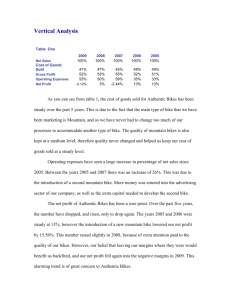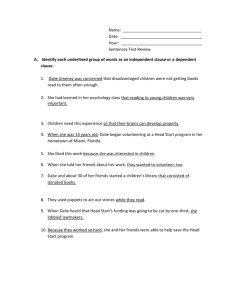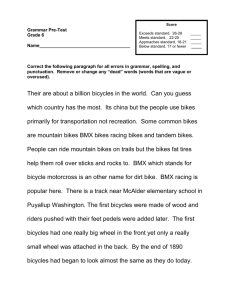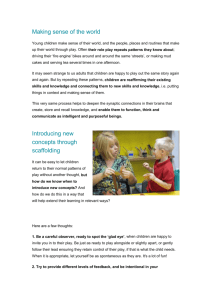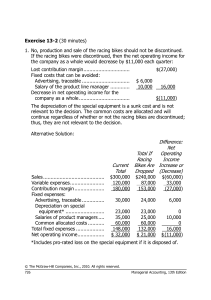NOTES FROM A CYCLE PATH: A BEGINNER'S GUIDE TO THE
advertisement
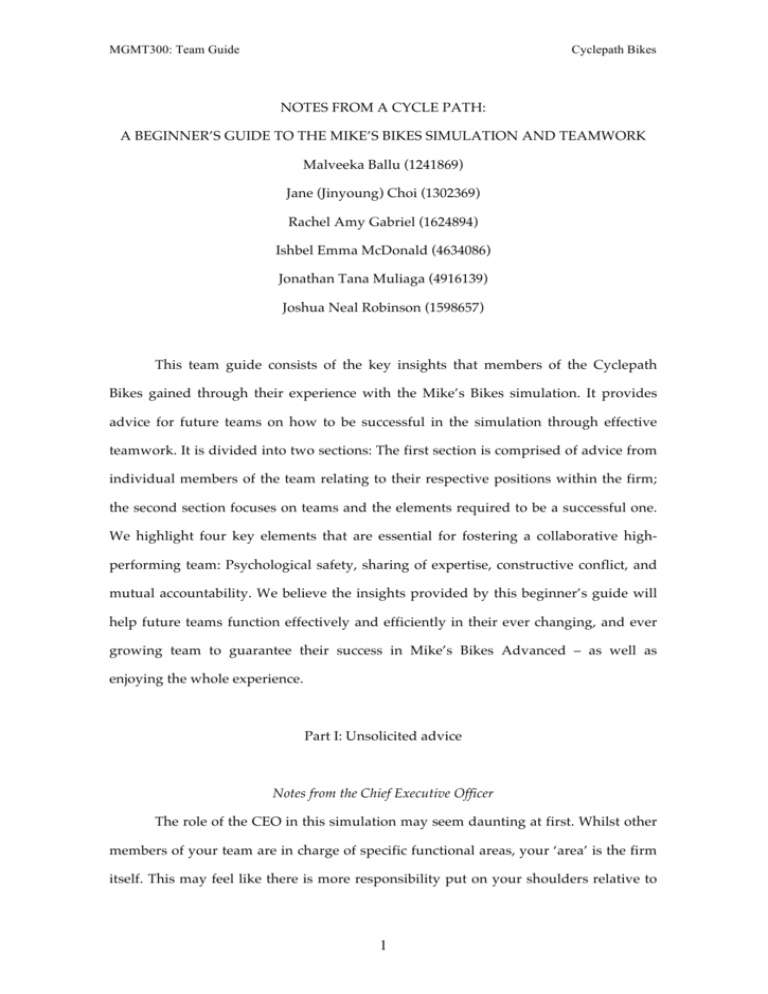
MGMT300: Team Guide Cyclepath Bikes NOTES FROM A CYCLE PATH: A BEGINNER’S GUIDE TO THE MIKE’S BIKES SIMULATION AND TEAMWORK Malveeka Ballu (1241869) Jane (Jinyoung) Choi (1302369) Rachel Amy Gabriel (1624894) Ishbel Emma McDonald (4634086) Jonathan Tana Muliaga (4916139) Joshua Neal Robinson (1598657) This team guide consists of the key insights that members of the Cyclepath Bikes gained through their experience with the Mike’s Bikes simulation. It provides advice for future teams on how to be successful in the simulation through effective teamwork. It is divided into two sections: The first section is comprised of advice from individual members of the team relating to their respective positions within the firm; the second section focuses on teams and the elements required to be a successful one. We highlight four key elements that are essential for fostering a collaborative highperforming team: Psychological safety, sharing of expertise, constructive conflict, and mutual accountability. We believe the insights provided by this beginner’s guide will help future teams function effectively and efficiently in their ever changing, and ever growing team to guarantee their success in Mike’s Bikes Advanced – as well as enjoying the whole experience. Part I: Unsolicited advice Notes from the Chief Executive Officer The role of the CEO in this simulation may seem daunting at first. Whilst other members of your team are in charge of specific functional areas, your ‘area’ is the firm itself. This may feel like there is more responsibility put on your shoulders relative to 1 MGMT300: Team Guide Cyclepath Bikes others. Having a strong team of people greatly helps to lighten the load, however if this is not the case then it is up to you to foster motivation and collaborative thought in the team. Setting a clear ‘big hairy audacious goal’ (BHAG) that resonates within every single team member will help to create the necessary attitudes to motivate your team – one that brings everyone together (Collins, 1999). As the CEO, this BHAG and the strategy to achieve it, must continuously be communicated to the team – especially when things do not go as planned, or your SHV has a negative trajectory. Use this BHAG to guide you when you are coordinating the decisions of your team members. However, be sure not to fall into the trap of unconditional agreement in terms of the decisions made - most members will have sound supporting arguments for their decisions thus it is up to the CEO to judge whether it will lead to achievement of the team’s BHAG or not. Ultimately, the final decisions are up to you. Rather than feeling overwhelmed with this responsibility, use the inherent knowledge of your whole team to make the best possible decision. Execution of your BHAG in the long-term is crucial to the success of your firm, so always keep your eye on the bigger picture when refining the details. Notes from the Chief Finance Officer Finance represents one of the most important aspects of the Mikes Bikes simulation. Most, if not all of the decisions in Mikes Bikes are made in terms of monetary value or dollar amounts, therefore keeping track of cash flows and ensuring that expenses are able to be covered is extremely important to being profitable in the simulation. A key contributor to the success of your group will be through the creation and implementation of a yearly budget. Normally done on a bi-monthly basis, a budget is simply a forecast of projected revenue and expenditure for a future period, largely based on results from previous periods. A budget can notify you of any overspending that could potentially occur, and can provide guidance on spending allocations to different sections of the organisation such as product development, 2 MGMT300: Team Guide Cyclepath Bikes human resources and marketing. This can simplify and streamline your team’s decision-making processes. In addition, you will find it useful to invest rather heavily on investor relations. The importance of this cannot be overstated. Investor relations expenditure represents funds that are periodically allocated specifically for the purpose of raising the public profile of the firm amongst the investment community. Our firm’s accumulated expenditure on investor relations was approximately $45 million over a period of 11 rollovers. Furthermore, investor relations acts as a share price multiplier, and can result in significant increases in shareholder value. We found that increasing this expenditure had the greatest effect when the firm was already doing well or profitable. This expenditure has a carry-over effect where half of the accumulated investor PR investment from the previous period will carry over to the following period. This cumulative expenditure equates to the investor PR index, which in turn acts as a share price multiplier. Another important aspect of finance is dividends. This is a key factor in the calculation of shareholder value; shareholder value being the sum of market share price and accumulated dividends paid. Dividend payments, therefore, directly affect shareholder value and represent a great way of using idle cash. Notes from the Director of Human Resources Firm capacity is comprised of plant and human capital. The effectiveness, thus optimum level of human capital, is shaped by salary and training. Our strategy focused on quality and efficiency, so we invested heavily in our people and their productivity. At the outset workers produce at around 370 SCU, yet can potentially produce at 625 SCU. As worker motivation and turnover are influenced by pay, you should increase remuneration significantly over the course of several rollovers. The initial staff turnover in Mike’s Bikes is problematic due to associated costs. However, with pay rises this rate quickly drops to zero. It is important to focus on the potential long-run capacity increases generated by rising skill levels from training. Invest well in 3 MGMT300: Team Guide Cyclepath Bikes excess of training recommended as sufficient in the MBA Players Manual. Though tempting as it maybe, it is important not to decrease training if you are hiring new workers, as this impacts by decreasing the overall average skill level. The correct number of staff can be difficult to estimate especially with new staff having a lower skill level. Be aware that when market growth slows, with skill and motivation levels increasing steadily it is easy to end up with too many staff and increasing idle time. Notes from the Director of Operations Supplier relations is a very important element of operations and influences a range of other factors. Essentially by investing in supplier relations you will ensure that the raw materials received from your supplier are of the best quality and will arrive on time. As you may have already discovered during your Mikes Bikes experience, all the decisions you make have a flow on effect; supplier relations is no different. With a heavy investment into supplier relations early on in the simulation, this will lead to an improvement in the delivery of products, reduce time wasted due to raw materials stock out, and better quality goods being produced. However, this is not to say that you should only invest in supplier relations; factors such as quality systems and preventative maintenance are also major factors in improving and maintaining high quality. You will want to invest in quality very early on if your strategy focuses on producing high-spec bikes, but this is not necessary if you are producing lower-spec bikes. Always keep in mind that no one decision is an island everything you do in Mike’s Bikes is interlinked with several other factors. Notes from the Director of Research and Development When you are thinking about product development, value engineering is essential. When developing a product, there is a specific formula used to work out the prime cost and the minimum spend needed to make the project successful. However, you need to think about what you actually want from the product. While it may be 4 MGMT300: Team Guide Cyclepath Bikes tempting to spend the minimum amount possible in order to minimize the effect that product development expenditure will have on profit, it is better in the long run to invest more in the development. This is because the more you invest in a product above the minimum calculated spend, the larger the decrease will be in the prime cost and SCU of the product. It will then cost less to produce each bike. This reduces the cost of goods sold for the product and the lower the cost of goods sold, the higher your profits. Even though you are spending a large amount on product investment, it will pay itself off quickly from the increased profits. Reducing your cost of goods sold is one of the main ways to increase the profits of your firm, so value engineering should be initiated right from the beginning of the simulation. Notes from the Director of Marketing Marketing in the Mikes Bikes simulation is a form of game theory. The aim is to spend as little as possible in product advertising, PR, and brand advertising while maximising its impact. However, firms must anticipate the advertising spends of their competition within the market, and ensure they do not fall behind. The key to this process revolves around budgeting. Work out budgets early into the weekly decisionmaking and make your allocations accordingly. A key point of money wastage is brand equity. The brand equity curve plateaus at a very low amount of expenditure. Early on, firms should aim for the one million dollar spending mark, as the gains increase substantially up to this point. However, beyond this point the effects will begin to level off. This amount should be reviewed later in the scenario, when the product portfolio is more substantial, and potentially increased to $1.5 million, as it becomes viable to spend that extra money to make the small awareness gains it provides across all the products. Firms must carefully examine the information provided by the simulation. The graphical representations show various spending thresholds as well as the proportions of spending required in each advertising medium. These would be of particular importance to you, as the Director of Markeitng. 5 MGMT300: Team Guide Cyclepath Bikes If these factors are properly examined, firms should be able to utilise marketing in a constructive way, without spending copious amounts for diminishing returns. Part II: There is no ‘I’ in TEAM Why having a good team matters While the actual decisions that you enter into Mikes Bikes play a major role in being a successful firm, having a cohesive team is very important in order to do well. Becoming a real team will mean that your performance will be greater than if you remain as a group of individuals (Katzenbach & Smith, 1992). If your team does not work well together then there will inevitably be large periods of time wasted with intragroup conflict, and team members may have trouble agreeing on tasks due to the pursuit of their own separate goals and objectives. It can be hard to become a real team in this course as the teams are allocated somewhat randomly, and it is not certain that you will find yourself in a team where everyone has the same goals and levels of commitment (Katzenbach & Smith, 1992). You cannot simply call yourself a team; you must actively work to establish a collective purpose and a common working approach. If you strive to move past the forming and storming phases quickly, your team will have a greater chance of entering the norming and performing phases (Tuckman, 1965). At this stage, team cohesiveness will be created, and you will be better able to make decisions and implement your strategy (Tuckman, 1965). We will discuss below some of the important steps that you can take to help you on your way to becoming a successful team. Creating a culture of psychological safety As you are unlikely to know the members of your team prior to coming together to work on the simulation, a lack of familiarity between team members can 6 MGMT300: Team Guide Cyclepath Bikes inhibit collaboration and the sharing of knowledge (Gratton & Erickson, 2007). For a team to thrive in Mike’s Bikes, high quality communication that includes idea sharing, issue questioning, debate and constructive conflict is essential. It is crucial to team success that a psychologically safe environment is established where team members are open to different perspectives and mutually support each other (Edmondson, Bohmer & Pisano, 2000). The focus is not about togetherness as in a pseudo-team, rather it remains about performance and getting equal contribution from each individual (Katzenbach & Smith, 1992). When contributing to a team there is an inherent risk of being perceived as ill-informed or foolish. Thus, team members must ensure the risk of embarrassment and ridicule from contributing to team discussion is minimized (Edmondson et al., 2000). The best way to create a psychologically safe culture is through repeatedly encouraging each other to contribute by actively asking others for their opinion, and making it clear that everyone’s contribution is valued (Edmondson et al., 2000). When people are at ease with each other, the team can make the most of discussion and come to better decisions. The sharing of expertise A central precursor to success in the Mike’s Bikes simulation is the sharing of expertise and knowledge amongst team members. Rorty (1979) views a team as a way of bringing together experts from various domains, where the team’s expertise is viewed as the aggregation of individual skills and knowledge. Theorists also view expertise as context dependent, where the team creates an environment where, through interactions, expertise can emerge (Brown & Duguid, 1991). Therefore, cultivating such an environment is fundamental to achieving your firm’s goals. This need for expertise-sharing is even more pronounced in the way that the Mike’s Bikes simulation is structured. As the executive roles are allocated to each team member, it is highly likely that a person may be allocated a position of which they have little or no experience in. Thus being able to utilise the collective knowledge and skills of the 7 MGMT300: Team Guide Cyclepath Bikes group becomes even more important. For example, if a team member has been allocated the CFO position and has little expertise in creating budgets, another team member with this knowledge could assist with this, for the benefit of the team. Although each team member should have a strong understanding of the workings of their role in the organisation and what they are responsible for, it is very important that team members are not restricted to these areas, as they may have strong expertise in other domains, which can benefit the firm as a whole. The process of constructive conflict The notion of constructive conflict, though counterintuitive it may seem, is invaluable to the decision making process of your team. Heated discussion and debate over significant decisions are ways of developing new insights, and ensuring that the basis for your decisions is sound (Katzenbach & Smith, 1992). Throughout your engagement with the simulation there is a looming danger of complacency, which can inhibit your ability to make quality decisions. Especially in situations where teams encounter early success, an air of invincibility and over-confidence can result. The outcome of this can be subpar decisions where money is rashly spent for negligible gains and will result in possible under-spending in important areas, such as value engineering. Moving past the forming stage and into storming can lead to a significant improvement in the decision-making process by introducing constructive conflict to the dynamics of your team. Conflict is valuable, and should not be shied away from. Whilst the ultimate goal is general consensus - it is the journey which defines the quality of decisions (Buchanan & O’Connell, 2006). “Consensus is good, unless it is achieved too easily, in which case it becomes suspect” (Buchanan & O’Connell, 2006, p. 36). By journey, this means the process whereby the team challenges all the ideas put forward by the members, thus forcing a deeper level of thought. Through conflict, every decision will be questioned in terms of its impact on the firm’s performance and the returns that will be generated. It also allows teams to ensure the decisions will 8 MGMT300: Team Guide Cyclepath Bikes align with the overarching strategy. It is much easier to simply agree with each other, and avoid conflict, however, this will inevitably lead to poor execution, poor firm performance and failure in the long-term. Generating mutual accountability Shifting from the niceties of the forming stage into the turbulent waters of the storming stage can be achieved faster when mutual accountability exists within your team. Essentially, it is this type of environment that our recommendations in this guide are able to take on its full effects. Mutual accountability of both failures and successes of the team will bring the members closer. It also allows team members to move beyond the boundaries of their individualistic attitudes thus creating a sense of community (Gratton & Erickson, 2007). This allows team members to feel more comfortable about reaching out to others and also more likely to share their knowledge and opinions (Gratton & Erickson, 2007). Much like Mike’s Bikes, establishing mutual accountability in your team will influence all other aspects of the team’s dynamics – there are a multitude of beneficial flow-on effects: Mutual accountability generates more psychological safety, which in turn encourages the sharing of expertise and knowledge, which then will lead to more open communication and constructive conflict. The resulting decisions will be of better quality than those made by one person alone. Synergy is created, with mutual accountability as its foundation. Better decisions will lead to better execution of your strategy, bringing you closer to achieving your BHAG than if you attempted it on your own. For all members of your team to embrace the notion of mutual accountability, the framework of your team dynamics must be set by. Through discussing the main issues and challenges each department can face, we have provided an outline of how to ensure you are cycling down the right path and how to deal with any bumps along the way. Following this, we examined how 9 MGMT300: Team Guide Cyclepath Bikes fostering a culture of psychological safety, the sharing of expertise, constructive conflict and mutual accountability are key to success in Mike’s Bikes. Without these aspects of the team, collaboration and communication will be stifled. Overall, Cyclepath Bikes’ experience of the simulation built upon each individual’s teamwork skills and has helped develop key workplace abilities that they can use in their future careers. We hope this beginner’s guide helps steer your firm in the right direction. Word count: 3180 10 MGMT300: Team Guide Cyclepath Bikes References Buchanan, L. & O’Connell, A. (2006). A brief history of decision making. Harvard Business Review, 84(1), 32-41. Brown, J. S., & Duguid, P. (1991). Organizational learning and communities-of-practice: Toward a unified view of working, learning, and innovation. Organization Science, 2(1), 40-57. Collins, J. (1999). Turning goals into results: The power of catalytic mechanisms. Harvard Business Review, 77(4), 70-82. Edmondson, A., Bohmer, R., & Pisano, G. (2001). Speeding up team learning. Harvard Business Review, 79(9), 125–132. Gratton, L., & Erickson, T. J. (2007). 8 ways to build collaborative teams. Harvard Business Review, 85(11), 100–109. Katzenbach, J. R., & Smith, D. K. (1992). Why teams matter. McKinsey Quarterly, 3, 3–27. Rorty, R. (1979). Philosophy and the Mirror of Nature. Princeton, NJ: Princeton University Press. Tuckman, B. W. (1965). Developmental Sequence in Small Groups. Psychological Bulletin, 63(6), 384-399. 11

